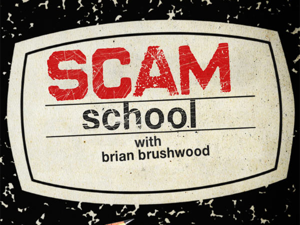 Scam School is back, and this week, they're teach one of my all-time favorite mathematical tricks!
Scam School is back, and this week, they're teach one of my all-time favorite mathematical tricks!
This is one of those tricks that appears simple, and isn't hard to do, but the reason why it even works in the first place is almost as magical as the performance.
Let's get right to the trick itself, shall we?
This is a classic of mathemagic. I've mentioned it many times on this site, and wrote about it in detail last August (You'll note I used the same Fibonacci video in my recent Fractal post).
If you want some practice multiplying by 11, The Math World features a post that includes practice exercises at the end.
Why does multiplying the 7th term by 11 always give the same answer? If you work it out algebraically, it's not difficult to see why. Assume we start with 2 numbers, which we'll call a and b. The numbers will then be as follows:
1. a
2. b
3. a + b
4. a + 2b
5. 2a + 3b
6. 3a + 5b
7. 5a + 8b
8. 8a + 13b
9. 13a + 21b
10. 21a + 34b
--------------
55a + 88b
Now, look at that 7th term, 5a + 8b. If you multiply that term by 11, it would work out as 11(5a + 8b), and multiplied out that comes to 55a + 88b! Like I said earlier, the fact that such a pattern exists in the first place seems magical.Let's take another look at the Fibonacci video I mentioned earlier:
Let's see what other interesting patterns we can gleam from this. First, is that the multiples of the variable follow the Fibonacci sequence: 1, 1, 2, 3, 5, 8, 13, 21, 34. This also means that the later consecutive numbers will have the same relationship as all Fibonacci numbers, the ratio φ (Phi).
Thanks to that, there a bonus effect you can do with this trick. Assume you've performed the Fibonacci trick, and have set the paper with the numbers on it to the side where you can't see it. Ask the person with the calculator to divide the 10th number by the 9th number, but not to let you see the result. Act as if you're trying to work it out mentally, and strain saying, "I believe it's something like...1.61?" The fact that you got that far in your head will be very amazing to most people.
If you like Scam School, and this Fibonacci pattern intrigues you, then you'll probably be thrilled to know that it can be used to win in special versions of Nim!
First, there's Fibonacci Nim. Like most versions of Nim, this is a take-away game in which the last person to remove an object is the winner. The new rules for Fibonacci Nim is that, on the first move, the first player must leave at least 1 object for the other player, and on each successive turn, the next player is limited to removing no more than twice the amount removed by the previous player.
If you'd like to play Fibonacci Nim for yourself, try this Javascript version. Explaining how to win requires more space than I have in this post, but I covered it in detail last September.
That's how you can use the Fibonacci numbers themselves to win Nim, but did you know there's a version that is based on φ itself? It's rather unusual, as you might guess.
Here is a page with a game called Queen Nim. As stated in the rules, There is a queen on the board left hand. The queen can go right or down. Goal of the game is to let no moves for your opponent. Thus, wins one who makes last move putting the queen to the right-bottom corner.
This doesn't seem like Nim, and certainly doesn't seem like it could have anything to do with φ! First, the reduced options for moves after each turn effectively replace the removal of objects, and make this version of Nim more subtle and harder to work out.
In this explanation, excerpted from Martin Gardner's book, Penrose Tiles to Trapdoor Ciphers, you not only learn how to find safe spaces for the game, but also exactly how φ comes into it! Thankfully, once you've memorized the safe spaces for a standard board, you don't need to do any mental math involving φ.




No Response to "Scam School Mathemagic"
Post a Comment